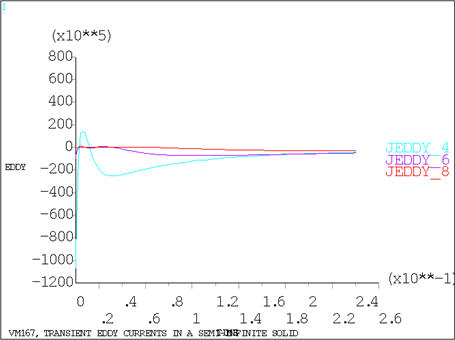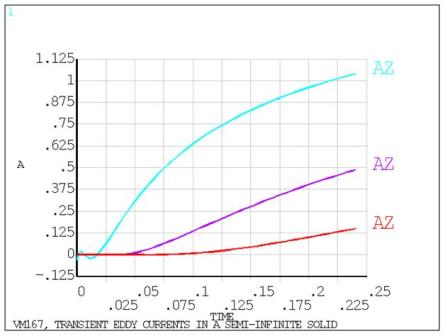VM167
VM167
Transient Eddy Currents in a Semi-Infinite Solid
Test Case
A semi-infinite solid is initially under no external magnetic
field (vector potential A is zero throughout). The surface is suddenly
subjected to a constant magnetic potential Ao. Determine the eddy current density, flux density and the vector
potential field solution in the solid during the transient.
Analysis Assumptions and Modeling Notes
A 0.4m2 area is arbitrarily selected
for the elements. The model length (20 m) is arbitrarily selected
such that no significant potential change occurs at the end points
(nodes 41, 91) for the time period of interest. The node locations
are defined with a higher density near the surface to accurately model
the transient behavior.
The transient analysis makes use of automatic time step optimization
over a time period of 0.24 sec. A maximum time step size ((.24/48)
= .005 sec.) is based on
 δ2/4 α, where δ is the conduction length within the first element
(δ = .0775m) and α is the magnetic diffusivity (α = ρ / μ = .31822 m2/sec.).
The minimum time step (.0002 sec) is selected as 1/25 of the maximum
time step. The starting time step of 0.0002 sec. is arbitrarily selected.
The problem is solved with two load steps to provide solution output
at the desired time points. In the first load step, the step potential
load is applied while setting initial boundary conditions of zero
at all other potentials. The problem is first solved with PLANE13 elements and then using PLANE233 elements. The eddy current density output is not available with PLANE233.
δ2/4 α, where δ is the conduction length within the first element
(δ = .0775m) and α is the magnetic diffusivity (α = ρ / μ = .31822 m2/sec.).
The minimum time step (.0002 sec) is selected as 1/25 of the maximum
time step. The starting time step of 0.0002 sec. is arbitrarily selected.
The problem is solved with two load steps to provide solution output
at the desired time points. In the first load step, the step potential
load is applied while setting initial boundary conditions of zero
at all other potentials. The problem is first solved with PLANE13 elements and then using PLANE233 elements. The eddy current density output is not available with PLANE233.
δ2/4 α, where δ is the conduction length within the first element
(δ = .0775m) and α is the magnetic diffusivity (α = ρ / μ = .31822 m2/sec.).
The minimum time step (.0002 sec) is selected as 1/25 of the maximum
time step. The starting time step of 0.0002 sec. is arbitrarily selected.
The problem is solved with two load steps to provide solution output
at the desired time points. In the first load step, the step potential
load is applied while setting initial boundary conditions of zero
at all other potentials. The problem is first solved with PLANE13 elements and then using PLANE233 elements. The eddy current density output is not available with PLANE233.





